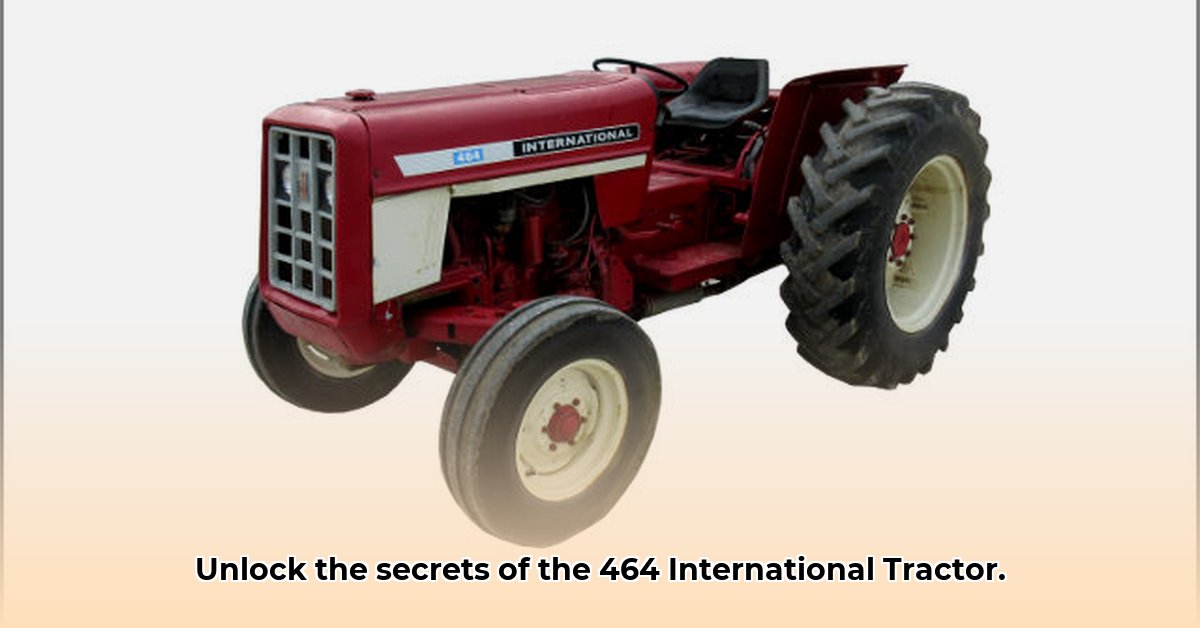
The International Harvester 464, a stalwart of 1970s agriculture, remains a coveted collectible among vintage tractor enthusiasts. Produced between 1973 and 1978, this robust machine offers a blend of reliable performance and intriguing history. This comprehensive guide delves into the 464's specifications, addresses inconsistencies in reported data, and provides invaluable guidance for restoration and maintenance. We'll uncover the secrets of this iconic workhorse, offering a blend of technical detail and practical advice. For more on 1980s International Harvester tractors, see this useful resource.
464 International Tractor: Unraveling the Power Puzzle
One immediate challenge when researching the IH 464 is the variation in reported horsepower. Different sources cite different figures, leading to understandable confusion. These discrepancies likely stem from several factors: varying testing methodologies employed decades ago, the natural variation between individual engines due to manufacturing tolerances, and the impact of wear and tear on used machinery. To provide clarity, we've compiled data from multiple sources, emphasizing the range of possible values.
| Source | Engine Type | Horsepower (Drawbar) | Horsepower (PTO) | Notes |
|---|---|---|---|---|
| Source A (TractorData.com) | Gasoline/Diesel | 38-45 hp | 41-45 hp | Range reflects observed variation |
| Source B (Tractor-Specs.net) | Gasoline/Diesel | ~45 hp | ~46 hp | Approximate figures, potential engine variations |
Remember, a well-maintained IH 464 will typically perform closer to the higher end of these horsepower ranges. Always consult multiple sources for a comprehensive understanding. Isn't it fascinating how even the simplest specifications can reveal the complexities of historical data?
Engine Specifications: Powering the Fields
Precise engine specifications like bore, stroke, displacement, and compression ratio can be difficult to find consistently across sources. The 464 was available with both gasoline and diesel engines, further complicating the search for exact figures. For the most accurate information, consult original International Harvester documentation for the specific year and engine type of your tractor. However, the general consensus points to powerful, yet dependable powerplants designed for rugged agricultural work.
Transmission, Hydraulics, and Braking: Essential Systems
The IH 464 featured an 8-speed synchromesh transmission, providing a smooth and efficient gear selection – a significant improvement over earlier designs. Its hydraulic system, typical for its era, offered reliable lifting capabilities for common agricultural tasks. The braking system employed independent hydraulic wet disc brakes, providing consistent and reliable stopping power. Detailed specifications for hydraulic capacity and braking system specifics might require consulting original documentation or conducting direct measurements on the tractor itself.
Historical Context: The IH 464 in its Time
The IH 464 reflects the technological landscape of the 1970s. It stands in contrast to today's technologically advanced tractors, lacking the sophisticated electronic controls and advanced features that are now commonplace. The absence of these features shouldn't diminish its importance. For its time, this tractor represented a significant step forward in farm machinery, providing farmers with a reliable and efficient tool. The tractor's approximate 1978 price of $8,500 (considerably more in today's dollars) further illustrates its position as a significant investment for farmers during this era.
Restoration and Maintenance: A Practical Guide
Restoring an IH 464 is a rewarding undertaking, but requires meticulous planning and a methodical approach. Follow these steps for a successful restoration:
Parts Sourcing: Utilize online forums dedicated to International Harvester tractors, specialized parts suppliers, and salvage yards to find necessary components. This stage can be time-consuming, but persistence often pays off.
Expert Mechanic: Seek out a mechanic experienced with vintage IH tractors. Their specialized knowledge is invaluable throughout the restoration and subsequent maintenance.
Safety First: Always disconnect the power source before performing any maintenance or repair. Wear appropriate safety gear, including gloves and eye protection. Safety should always be the top priority when working with vintage machinery.
Regular Maintenance: Adhere to regular maintenance schedules, including timely oil changes, filter replacements, and fluid level checks, following the manufacturer's recommendations or reliable equivalent sources.
Addressing Wear and Tear: Proactively inspect and address wear and tear to prevent larger issues down the line.
Budgeting: Develop a comprehensive budget accounting for parts, labor costs, and potential unforeseen repairs. It is essential to budget conservatively, to avoid unforeseen financial constraints.
Conclusion: A Legacy of Power and Resilience
The International Harvester 464 embodies a legacy of rugged dependability, representing a key stage in the evolution of agricultural machinery. While precise specification data can be challenging to pinpoint due to inconsistencies in reporting and the passage of time, the tractor's enduring popularity speaks to its quality and enduring appeal. When researching vintage machinery, remember that consulting multiple sources and understanding the limitations of historical data are crucial for gaining a complete picture. Always prioritize safety when working on vintage equipment.